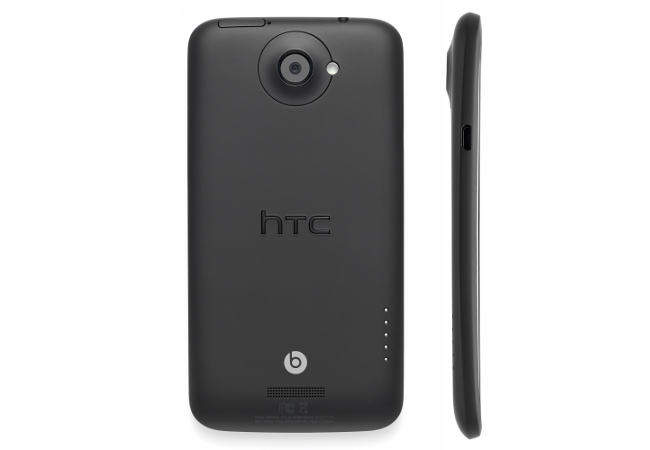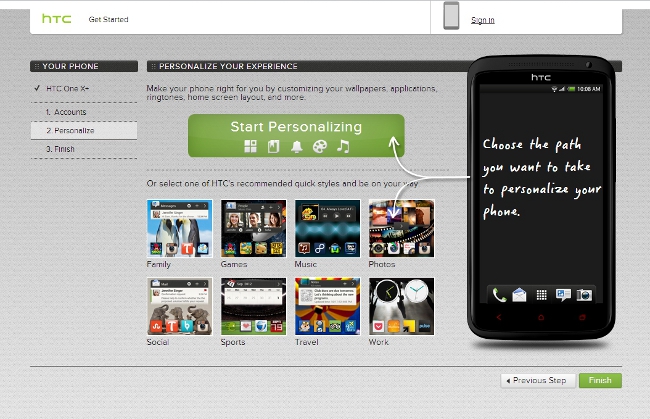The HTC One X+ is a slight upgrade on the HTC One X, the flagship device that was top of the class until the likes of the Samsung Galaxy S III and the iPhone 5 came along. But is the plus factor strong enough to make HTC the critics’ darling once more?
Look and feel
Just 5g heavier than the One X, the One X+ is otherwise practically identical to the original. The 4.7-inch Super LCD 2 display comes with optical lamination, which means that the screen remains clear and bright even in bright light and at extreme angles.
The slightly curved casing features a matt black finish, and the SIM card tray is almost imperceptible. In fact, it can only be accessed using an eject tool provided – which users will have to be careful not to lose.

User interface
Android is now competing with the highly customisable Windows Phone 8 interface (which HTC also supports with its new Windows Phone 8X), but HTC has made sure to make personalisation of the One X+ easy for users.
With its new HTC Get Started website, users are guided through customising their phone with the wallpaper, applications, ringtones, home screen layout and widgets to suit their needs and preferences. There’s also a range of quick style templates under themes like Social, Work, Photos and Travel.

The combination of HTC’s latest UI, HTC Sense 4+, and Jelly Bean 4.1 is simply marvellous. Native apps are a joy to work with – even the weather app constantly delighted me with its animated updates on my home and lock screens.
Overall, the interface feels more sophisticated and fluid than Samsung’s TouchWiz and any other Android UI I’ve tried. However, it wasn’t without its issues, such as delayed haptic feedback when typing very quickly.
Audio
Beats Audio technology on the One X+ gives both the built-in speaker and headphone sound added depth and clarity, and a volume boost – particularly the bass. Overall, the sound from this handset is clear and unmistakeable. Unlike the myriad other phones I’ve carried, I could almost always hear the One X+ when I received a message or call and the phone was my bag or pocket.

Headphones supplied with the HTC One X+, shot with the HTC One X+
I took one look at the large buds on the HTC earphones supplied with the device and thought they would be uncomfortable and ill-fitting. Thankfully, I was completely wrong. They fit better than I imagined and not a sound leaked from them as they were in my ears. HTC clearly gives a damn when it comes to using your phone as an on-the-go media player.
The headphones also come with a remote button for use as a hands-free component, or the button can be pressed to launch Google Voice, which is handy.
Performance
The One X+’s 1.7GHz Nvidia Tegra 3 quad-core processor (0.2GHz faster than the One X), apparently comes with an additional fifth battery-saver core that promotes longer battery life. Not that this device needs it with a massive 2,100mAh embedded battery at its disposal.
HTC One X+ – Tech Specs
- Android 4.1.1 Jelly Bean
- 1.7GHz Nvidia Tegra 3 quad-core processor
- 32GB or 64GB internal storage
- 1GB RAM
- 720 x 1,280 pixels, 4.7-inch Super LCD 2 HD display
- 8MP rear camera, 1080p HD video
- 1.6MP front-facing camera
- Beats Audio
- 2,100mAh battery
Using the power-saving mode, I found I could easily get two days out of my device with regular use, so I can certainly vouch for HTC’s longest-lasting battery yet.
Performance was fast and steady on the One X+, with very few hiccups and no serious issues. The device also claims faster 4G speeds, but we aren’t going to be able to test that for some time now.
Camera
The One X+ camera still comes at a healthy 8MP and with an f2.0 29mm lens, but the interface has had a slight overhaul to be more user friendly. The shutter button has been enlarged and touchscreen zoom controls are now more conveniently positioned, plus there’s a new on-screen button to toggle between trhe front and rear cameras.
What most impressed me is that the One X+ can get a shot no matter what the lighting situation – low light, backlight or even no light using HDR mode. This takes three rapid shots at different exposures, merging these into one optimised image.

Left: Image of a road in the dark shot on HTC One X+; Right: The same image shot using HTC One X+ with HDR mode on
HTC ImageSense and the HTC ImageChip do a good job of rendering clear photographs, and users can even snap away while shooting HD video, while continuous shooting can take four shots per second for up to 99 images in a row.
The real upgrade can be seen with the front-facing camera, which is now 1.6MP instead of the former 1.3MP. It’s great quality for what is usually a sub-standard feature, and comes with the same filter options as the rear camera.

Left: Image shot using HTC One X+ rear camera and Vintage filter; Right: Image shot using HTC One X+ rear camera auto settings
Video recording with the rear camera comes at 1080p HD while the front-facing camera can capture 720p HD.
At the end of the day, it’s still a smartphone camera, but it’s definitely one of the best I’ve seen.
Verdict
While I loved the new HTC Sense 4+ UI, I did have some very slight issues with it. Sometimes controls were not intuitive or something wouldn’t be where I’d expect it to be and this would slow me down as I was using the device, and other times the accelerometer was too sensitive, flipping the screen just because I tilted the phone slightly during one-handed usage.
But then there were other aspects that impressed me, such as the predictive text, which was far better at correcting my typing than on any other device I’ve tried. And then there are the big pluses in terms of features, like the camera and its range of capabilities, and the outstanding battery performance.
For these points, I can overlook the niggly details and say that the HTC One X+ is my favourite smartphone on the market today.